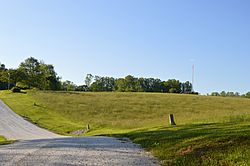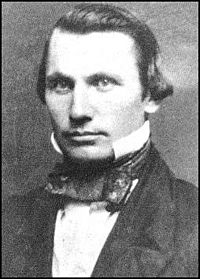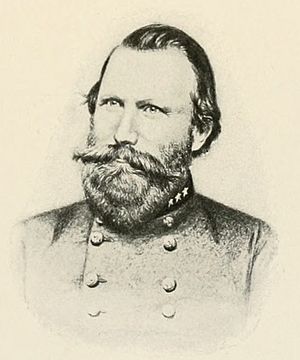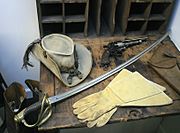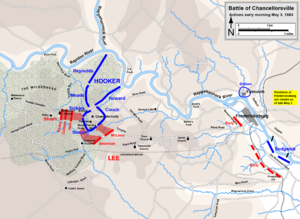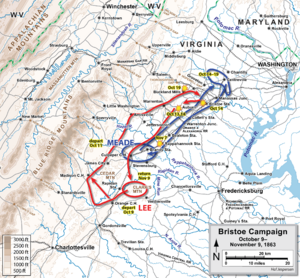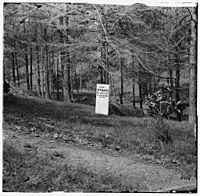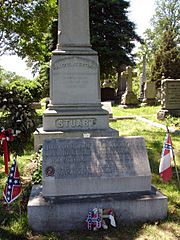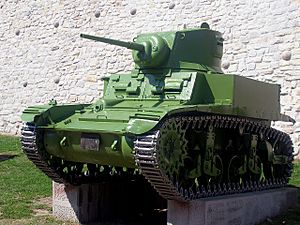J. E. B. Stuart facts for kids
Quick facts for kids
J. E. B. Stuart
|
|
|---|---|
 |
|
| Birth name | James Ewell Brown Stuart |
| Nickname(s) | "Jeb," "Beauty," "Knight of the Golden Spurs" |
| Born | February 6, 1833 Patrick County, Virginia, U.S. |
| Died | May 12, 1864 (aged 31) Richmond, Virginia |
| Buried |
Hollywood Cemetery,
Richmond, Virginia, U.S. |
| Allegiance |
|
| Service/ |
|
| Years of service |
|
| Rank |
|
| Commands held |
|
| Battles/wars | |
| Signature | |
James Ewell Brown "Jeb" Stuart (born February 6, 1833 – died May 12, 1864) was an officer in the United States Army. He was from Virginia. Later, he became a general in the Confederate States Army during the American Civil War. His friends called him "Jeb" because of his initials.
Stuart was a skilled cavalry commander. He was great at finding out where the enemy was (reconnaissance). He also used cavalry to help his army attack. He liked to look fancy with a red-lined gray cape and a hat with an ostrich feather. But he was also very serious about his work. He was like the "eyes and ears" for General Robert E. Lee's army. He also helped keep up the spirits of the Southern soldiers.
Stuart finished school at West Point in 1854. He then served in the U.S. Army in Texas and Kansas. He fought in conflicts with Native Americans. He also saw the violence of Bleeding Kansas. He even helped capture John Brown at Harpers Ferry.
When his home state of Virginia left the United States, Stuart quit the U.S. Army. He joined the Confederate Army. He first served under Stonewall Jackson in the Shenandoah Valley. Then he took on bigger roles in the cavalry of the Army of Northern Virginia. He was part of all their major battles until he died.
Stuart became known as a brave cavalry leader. Twice, he rode all the way around the Union Army of the Potomac. This happened during the Peninsula Campaign and the Maryland Campaign. These rides made him famous and embarrassed the North. At the Battle of Chancellorsville, he even took temporary command of Stonewall Jackson's infantry (foot soldiers) when Jackson was hurt.
His most famous campaign was the Gettysburg Campaign. But it had a big problem. Stuart was separated from Lee's army for too long. This meant Lee didn't know where the Union troops were moving. So, Lee was surprised and almost trapped at the Battle of Gettysburg. Stuart faced criticism for this after the war. In 1864, during the Overland Campaign, Union General Philip Sheridan's cavalry attacked to defeat Stuart. Stuart was badly wounded at the Battle of Yellow Tavern and died soon after.
Contents
Early Life and Education
Jeb Stuart was born at Laurel Hill Farm. This was a plantation in Patrick County, Virginia. It was close to the North Carolina border. He was the eighth of eleven children. He was the youngest of five sons who lived past childhood. His father, Archibald Stuart, was a veteran of the War of 1812. He was also a lawyer and a politician. He owned slaves. His mother, Elizabeth Letcher Pannill Stuart, managed the family farm. She was known as a very religious woman and good at business.
Stuart's family had Scottish roots. His great-grandfather, Major Alexander Stuart, fought in the American Revolutionary War. He led a regiment at the Battle of Guilford Court House.
School Days
Stuart was taught at home by his mother and other teachers. This lasted until he was twelve. Then he went to school in Wytheville, Virginia. He also studied at his aunt and uncle's home in Danville. He started at Emory and Henry College when he was fifteen. He attended from 1848 to 1850.
In 1848, Stuart tried to join the U.S. Army. But he was too young. In 1850, he got into the United States Military Academy at West Point, New York. He was a popular student and liked the Academy. His classmates called him "Beauty." They joked that his beard, which he grew after graduation, made him look much better.
Robert E. Lee became the head of the Academy in 1852. Stuart became friends with Lee's family. Lee's nephew, Fitzhugh Lee, also came to the Academy in 1852. In his last year, Stuart was a high-ranking cadet. He was also one of eight cadets chosen as "cavalry officers" for his great riding skills. Stuart graduated 13th in his class of 46 in 1854. He was tenth in his class for cavalry tactics.
Service in the United States Army
Stuart became a brevet second lieutenant. He was sent to the U.S. Regiment of Mounted Riflemen in Texas. He arrived at Fort Davis in January 1855. For three months, he led scouting missions. Soon, he moved to the new 1st Cavalry Regiment. This was at Fort Leavenworth, Kansas Territory. He became an officer in charge of supplies. He was promoted to first lieutenant in 1855.
Marriage and Family Life
In 1855, Stuart met Flora Cooke. She was the daughter of Lieutenant Colonel Philip St. George Cooke. He was the commander of the 2nd U.S. Dragoon Regiment. They got engaged in September, less than two months after meeting. Stuart joked in Latin, "I came, I saw, I was conquered." His father died on September 20, so their wedding on November 14 was small.
Their first child, a girl, was born in 1856 but died the same day. On November 14, 1857, Flora gave birth to another daughter, also named Flora. In early 1858, the family moved to Fort Riley. They lived there for three years. The couple owned two slaves until 1859. One was from his father's estate, and the other he bought.
Fighting in Bleeding Kansas
Stuart quickly showed he was a good leader. He had experience fighting Native Americans on the frontier. He also saw the violence in Bleeding Kansas before the war. On July 29, 1857, he was wounded fighting the Cheyenne at Solomon River, Kansas. His commander ordered a charge with swords. Stuart and three other officers chased a warrior. Stuart shot him in the leg. The Cheyenne fired back, hitting Stuart in the chest. The bullet only pierced his skin. Stuart returned to Fort Leavenworth in September and was reunited with his wife.
John Brown's Raid
In 1859, Stuart invented a new piece of cavalry equipment. It was a saber hook for attaching swords to belts. He got a patent for it and the U.S. government paid him $5,000 to use it. While in Washington, D.C., Stuart heard about John Brown's raid. Brown attacked the U.S. Arsenal at Harpers Ferry. Stuart volunteered to help Colonel Robert E. Lee. He went with Lee and U.S. Marines. Stuart delivered Lee's demand for surrender to Brown. Stuart recognized Brown from his time in Kansas.
Leaving the U.S. Army
Stuart was promoted to captain on April 22, 1861. But he resigned from the U.S. Army on May 3, 1861. He joined the Confederate States Army after Virginia left the Union. On June 26, 1860, Flora gave birth to a son. They named him Philip St. George Cooke Stuart. But his father changed the name to James Ewell Brown Stuart, Jr. ("Jimmie") in late 1861. This was because his father-in-law, Colonel Cooke, stayed with the U.S. Army. Stuart was very upset about this.
Confederate Army Service
Early Days in the War
Stuart became a lieutenant colonel in the Confederate Army on May 10, 1861. General Robert E. Lee ordered him to report to Colonel Stonewall Jackson at Harper's Ferry. Jackson ignored Stuart's infantry rank. On July 4, he put Stuart in charge of all cavalry companies in the Confederate Army of the Shenandoah. This became the 1st Virginia Cavalry Regiment. Stuart was promoted to colonel on July 16.

After serving in the Shenandoah Valley, Stuart led his regiment at the First Battle of Bull Run. This is where Jackson got his nickname, "Stonewall." Stuart's men chased the Union soldiers as they retreated. He then commanded outposts along the upper Potomac River. Later, he was given command of the cavalry brigade for the army. This army was first called the Army of the Potomac. It was later named the Army of Northern Virginia. He was promoted to brigadier general on September 24, 1861.
Peninsula Campaign
In 1862, the Union Army of the Potomac started its Peninsula Campaign. They were trying to capture Richmond, Virginia. Stuart's cavalry helped General Joseph E. Johnston's army. They retreated up the Virginia Peninsula because the Union army was much larger. Stuart fought at the Battle of Williamsburg. But the land and weather on the Peninsula were not good for cavalry.
However, when General Robert E. Lee took command, he asked Stuart to scout. Lee wanted to know if the Union army's right side was weak. Stuart left with 1,200 horsemen on June 12. He found that the Union flank was indeed weak. He then rode his men all the way around the Union army. He returned after 150 miles on June 15. He brought back 165 captured Union soldiers and many horses and supplies. His men met little resistance from the Union cavalry. This cavalry was, by chance, led by his father-in-law, Colonel Cooke. Stuart's men only lost one soldier. This ride was a huge success. Stuart was cheered in Richmond. He became as famous as Stonewall Jackson in the Confederacy.
Northern Virginia Battles
Early in the Northern Virginia Campaign, Stuart was promoted to major general on July 25, 1862. His command became the Cavalry Division. He was almost captured in August. He lost his famous plumed hat and cloak to Union soldiers. But in a revenge raid the next day, he attacked Union General John Pope's headquarters. Stuart captured Pope's uniform. He also found orders that gave Lee important information about Union reinforcements.
At the Second Battle of Bull Run, Stuart's cavalry followed a large attack by Confederate foot soldiers. They protected the army's side with artillery. Stuart ordered his men to chase the retreating Union soldiers. In a tough fight, Stuart's men captured over 300 Union soldiers. Stuart's men kept bothering the retreating Union columns. The campaign ended at the Battle of Chantilly.
Maryland Campaign
During the Maryland Campaign in September 1862, Stuart's cavalry hid the army's movement north. He was partly responsible for Lee not knowing where the Union army was. For five days, Stuart rested his men and had a big party. His reports don't mention his scouts gathering information. As the Union Army got closer to Lee's divided army, Stuart's men fought small battles. He misjudged the Union's path. He didn't know about the Union force threatening Turner's Gap. He needed help from foot soldiers to defend the mountain passes. This happened at the Battle of South Mountain. His horse artillery fired at the Union army's side at the Battle of Antietam. Jackson ordered Stuart to try a turning movement with his cavalry. But this attack never happened.
Three weeks after Lee's army went back to Virginia, Stuart made another bold ride. This was on October 10–12, 1862. It was his Chambersburg Raid. He rode 126 miles in less than 60 hours. He went as far north as Chambersburg. He once again embarrassed the Union. He also took horses and supplies. But his men and animals were exhausted. It didn't give much military advantage. Jubal Early called it "the greatest horse stealing expedition." Stuart gave his friend Jackson a new officer's coat. He thought it would make Jackson look more like a proper general. Jackson didn't care much about his appearance.
General McClellan slowly moved his army south. President Lincoln wanted him to chase Lee. McClellan started crossing the Potomac on October 26. Stuart's cavalry fought many small battles in early November. This was against Union cavalry and infantry. On November 6, Stuart received sad news. His daughter Flora had died of typhoid fever just before her fifth birthday.
Fredericksburg and Chancellorsville
In the December 1862 Battle of Fredericksburg, Stuart and his cavalry protected Stonewall Jackson's side. General Lee praised his cavalry. He said they "effectively guarded our right." Stuart told his wife Flora that he was shot through his fur collar but was not hurt.
After Christmas, Lee ordered Stuart to raid north of the Rappahannock River. He wanted Stuart to find out where the enemy was. Stuart also needed to cause damage. Stuart's raid went four miles south of Fairfax Court House. He captured 250 prisoners, horses, and supplies. His signalmen tapped telegraph lines. They intercepted messages between Union commanders. Stuart even sent a personal telegram to a Union general. He wrote, "General Meigs will in the future please furnish better mules; those you have furnished recently are very inferior."
On March 17, 1863, Stuart's cavalry fought a Union raiding party. This was at Kelly's Ford. The small victory was sad because Major John Pelham died. Stuart was very sad, as he saw Pelham like a younger brother. He wrote that Pelham was "noble, chivalric, gallant." Flora was pregnant at the time. Stuart told her that if it was a boy, he wanted to name him John Pelham Stuart. (Their daughter, Virginia Pelham Stuart, was born later.)
At the Battle of Chancellorsville, Stuart went with Stonewall Jackson. This was during Jackson's famous flanking march on May 2, 1863. Stuart started chasing the retreating Union soldiers. Then he heard that both Jackson and his senior commander, General A. P. Hill, were wounded. Hill sent a message ordering Stuart to take command of the Second Corps. This change of command slowed the attack on May 2. But Stuart did well as an infantry commander the next day. He launched a strong attack against the Union right side at Chancellorsville. When Union troops left Hazel Grove, Stuart quickly took it. He then fired artillery at the Union positions. Stuart gave up his infantry command on May 6 when Hill returned.
Stonewall Jackson died on May 10. Stuart was again very sad to lose a close friend. He called Jackson's death a "national disaster." Jackson's wife, Mary Anna, thanked Stuart for his sympathy. She said Jackson often spoke of Stuart as a close friend and admired his soldier skills.
Brandy Station Battle
Stuart returned to the cavalry for the Gettysburg Campaign. He faced two difficult moments in his career. The first was the Battle of Brandy Station. This was the largest cavalry battle of the war. By June 5, two of Lee's infantry corps were camped near Culpeper. Six miles northeast, Stuart's cavalry was camped near Brandy Station. They were hiding the Confederate Army from the enemy. Stuart asked General Lee to review his troops. This review on June 5 included almost 9,000 horsemen. They charged in a practice battle.
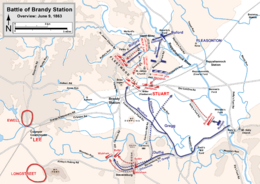
Lee could not attend, so the review was repeated on June 8. This time it was just a parade. Some cavalrymen and reporters complained that Stuart was just showing off. They said he was tiring out the horses. Lee ordered Stuart to cross the Rappahannock the next day. He was to raid Union positions. He also needed to hide the Confederate Army as it moved north. Stuart ordered his tired troops back to camp near Brandy Station.
Union General Joseph Hooker thought Stuart's presence meant a raid on his supply lines. So, he ordered his cavalry commander, General Alfred Pleasonton, to attack. Pleasonton had 8,000 cavalry and 3,000 infantry. He was to "scatter and destroy" Stuart's 9,500 Confederates. Pleasonton's force crossed the Rappahannock in two groups on June 9, 1863. The first group surprised Stuart at Beverly's Ford. The second group surprised Stuart again at Kelly's Ford. The Confederates were attacked from the front and back. There was a fierce fight with mounted soldiers. After ten hours, Pleasonton ordered his men to retreat.
Stuart claimed victory because the Confederates held the field. But Brandy Station is seen as a tie. Pleasonton could not stop Stuart's force. He also left before finding Lee's infantry nearby. However, the Southern cavalry did not detect the Union cavalry's movement. They were surprised. This was embarrassing for Stuart. He faced criticism from other generals and the Southern press. The battle also showed that the Union cavalry was getting better. This hinted that the once unbeatable Southern cavalry was declining.
Stuart's Ride to Gettysburg

After some small cavalry battles in June, Lee's army marched north. Stuart might have wanted to ride around the enemy army again. He wanted to fix his reputation after the Brandy Station surprise. General Lee gave Stuart orders on June 22. Stuart was to guard mountain passes with some of his force. This was while the army was south of the Potomac. He was then to cross the river with the rest of the army. He was to hide the right side of Ewell's Second Corps. But Stuart chose a different route. He took his three best brigades between the Union army and Washington. He moved north through Rockville to Westminster and into Pennsylvania. He hoped to capture supplies and cause trouble near the enemy capital. Stuart and his brigades left on June 25.
Unfortunately for Stuart, the Union army was already moving. His chosen path was blocked by Union foot soldiers. This forced him to go farther east than he or Lee expected. This stopped Stuart from meeting Ewell as ordered. It also meant Lee didn't have his main cavalry force. The cavalry was the "eyes and ears" of the army. This happened as Lee moved into unknown enemy territory.
Stuart's command crossed the Potomac River on June 28. At Rockville, they captured 140 new, fully loaded wagons. These wagons slowed Stuart down. But he thought Lee's orders meant gathering supplies was important. The Confederate raiders caused worry in Washington. Two Union cavalry brigades were sent to chase them. Stuart supposedly said if his horses weren't tired, he would have captured President Lincoln.
In Westminster on June 29, his men fought briefly with Union cavalry. They chased them a long way. Stuart claimed this caused "great panic" in Baltimore. The front of Stuart's column met Union cavalry at Hanover on June 30. They scattered them. The Battle of Hanover ended after the Union men regrouped and drove the Confederates out. Stuart's brigades were better at guarding their captured wagons than fighting. After a 20-mile ride in the dark, his tired men reached Dover on July 1. The Battle of Gettysburg was already starting without them.
Stuart then headed for Carlisle. He hoped to find Ewell. He fired some shells into town on July 1. He burned the Carlisle Barracks. Then he moved south towards Gettysburg. He and most of his command reached Lee at Gettysburg on the afternoon of July 2. He ordered Wade Hampton to cover the left rear of the Confederate lines. Hampton fought at the Battle of Hunterstown before joining Stuart at Gettysburg.
Gettysburg and Aftermath
When Stuart arrived at Gettysburg on the afternoon of July 2, he brought the captured Union supply wagons. Lee gave him a rare scolding. No one heard their private talk. But people at headquarters said Lee's greeting was "abrupt and frosty." Colonel Edward Porter Alexander wrote, "Although Lee said only, 'Well, General, you are here at last,' his manner implied rebuke." On the last day of the battle, Stuart was ordered to go behind the enemy. He was to cut their communication lines. This was at the same time Pickett's Charge attacked the Union positions. But his attack on East Cavalry Field was stopped by Union cavalry.
During the retreat from Gettysburg, Stuart focused on helping the army move. He successfully protected against Union cavalry chases. He also escorted thousands of wagons with wounded men and supplies. This was over difficult roads and in bad weather. Many small battles happened during the retreat. Stuart's men were the last to cross the Potomac River. They returned to Virginia in "wretched condition."
The Gettysburg Campaign was the most debated part of Stuart's career. He became one of the people blamed for Lee's loss at Gettysburg. This was by those who supported the "Lost Cause movement" after the war. Some writers, like Stuart's subordinate Thomas L. Rosser, also blamed him. Rosser said Stuart "undoubtedly, make the fatal blunder which lost us the battle of Gettysburg."
One of the strongest defenses of Stuart after the war came from Colonel John S. Mosby. Mosby had served under Stuart and was very loyal. He wrote, "He made me all that I was in the war." Mosby wrote many articles and a book in 1908. He used his lawyer skills to deny all claims against Stuart.
Historians still disagree on how much Stuart's failure to inform Lee caused the Gettysburg defeat. Edward G. Longacre says Lee gave Stuart a lot of freedom in his orders. Edwin B. Coddington calls Stuart's role in the Gettysburg Campaign a "tragedy." He says Stuart did not use his freedom wisely. Eric J. Wittenberg and J. David Petruzzi say there was "plenty of blame to go around." They say the fault should be shared by Stuart, Lee's unclear orders, and Richard S. Ewell. Ewell might have tried harder to meet Stuart. Jeffry D. Wert agrees that Lee, his officers, and the Union army's fighting caused the Confederate loss. But he says "Stuart failed Lee and the army."
Stuart was not officially punished for his role in the Gettysburg campaign. But it's worth noting that his appointment to corps command on September 9, 1863, did not come with a promotion. All other corps commanders in Lee's army were lieutenant general. Lee kept Stuart at major general rank. At the same time, he promoted Stuart's subordinates to major generals. This might be seen as a quiet scolding. Wert wrote that there is no proof Lee considered Stuart's performance. He thinks it's "more likely that Lee thought the responsibilities in command of a cavalry corps did not equal those of an infantry corps."
Later Campaigns and Death
Lee reorganized his cavalry on September 9, 1863. He created a Cavalry Corps for Stuart with two divisions. In the Bristoe Campaign, Stuart was to lead a wide turning movement. He tried to get behind the enemy. But General Meade skillfully pulled back his army. This left Stuart with no chances to attack. On October 13, Stuart accidentally ran into the back of the Union III Corps. This led to the First Battle of Auburn. Ewell's corps was sent to rescue him. But Stuart hid his horsemen in a wooded area. The Union corps moved on without knowing. So, help was not needed.
As Meade retreated, Union troops fought Stuart's cavalry and infantry. This was near Auburn on October 14. Stuart's cavalry bravely tricked the Union infantry. They escaped disaster. After a Confederate defeat and a failed advance, Stuart's cavalry protected Lee's army as it retreated. Union cavalry chased Stuart's cavalry. But they were led into a trap and defeated. The Union soldiers were scattered. This event became known as the ""Buckland Races"." The Southern newspapers started to praise Stuart again after his good performance.
The Overland Campaign began in spring 1864. This was General Ulysses S. Grant's attack against Lee. At the Battle of the Wilderness, Stuart aggressively sent his Laurel Brigade to fight. They fought against George Custer's better-armed Michigan Brigade. This caused many losses. General Lee sent Stuart a message: "It is very important to save your Cavalry & not wear it out." As the armies moved towards Spotsylvania Court House, Stuart's cavalry fought to delay the Union army. His defense at Laurel Hill skillfully delayed the Union army for almost 5 crucial hours.
Yellow Tavern and Stuart's Death
The Union commanders, General George Meade and General Philip Sheridan, argued about the cavalry's performance. Sheridan angrily said he wanted to "concentrate all of cavalry, move out in force against Stuart's command, and whip it." Meade told Grant, who replied, "Did Sheridan say that? Well, he generally knows what he is talking about. Let him start right out and do it." Sheridan immediately planned a raid. He attacked Confederate supply lines near Richmond. He knew this would make Stuart fight.
Sheridan moved quickly. He crossed the North Anna River and captured Beaver Dam Station. His men captured a train. They freed 3,000 Union prisoners. They also destroyed over a million rations and medical supplies for Lee's army. Stuart sent about 3,000 cavalrymen to stop Sheridan's cavalry. Sheridan's force was more than three times larger. As Stuart rode to chase them, he briefly stopped to see his wife, Flora, and his children, Jimmie and Virginia. Stuart told his aide, "He told me he never expected to live through the war, and that if we were conquered, that he did not want to live."
The Battle of Yellow Tavern happened on May 11. It was at an old inn six miles north of Richmond. The Confederate troops fought from a low ridge for over three hours. Stuart led a counterattack. He pushed the Union soldiers back from the hilltop. Stuart, on horseback, shouted encouragement. He fired his revolver at the Union soldiers.
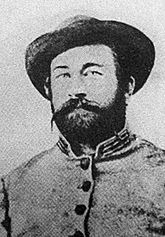
As the 5th Michigan Cavalry retreated past Stuart, a Union soldier named John A. Huff shot Stuart. Huff was 44 years old and dismounted. He shot Stuart with his .44-caliber revolver from 10–30 yards away. The bullet hit Stuart in his left side. It went through his stomach and came out his back. Stuart fell into the arms of Company K's commander, Gus W. Dorsey. Dorsey refused to leave him. He brought Stuart to the back.
Stuart was in great pain. An ambulance took him to Richmond. He went to the home of Dr. Charles Brewer, his brother-in-law. Stuart wanted to wait for his wife. As he was driven from the field, Stuart saw his men retreating in disorder. He called out his last words on the battlefield: "Go back, go back, and do your duty, as I have done mine, and our country will be safe. Go back, go back! I had rather die than be whipped."
Stuart asked for his sword and spurs to be given to his son. Confederate President Jefferson Davis came in. He took Stuart's hand and asked, "General, how do you feel?" Stuart answered, "Easy, but willing to die, if God and my country think I have fulfilled my destiny and done my duty." His last whispered words were: "I am resigned; God's will be done." He died at 7:38 p.m. on May 12. He was 31 years old. Flora Stuart did not reach his side before he passed. Stuart was buried in Richmond's Hollywood Cemetery. When General Lee heard of Stuart's death, he reportedly said he could hardly stop weeping. He said Stuart had never given him bad information. John Huff, the soldier who shot Stuart, was killed in action a few weeks later. This happened at the Battle of Haw's Shop.
Flora wore black for the rest of her life. She never remarried. She lived in Saltville, Virginia, for 15 years after the war. There, she opened and taught at a school. From 1880 to 1898, she was the principal of the Virginia Female Institute. Robert E. Lee had recommended her for this job before he died. In 1907, the institute was renamed Stuart Hall School in her honor. When her daughter Virginia died in 1898, Flora left the institute. She moved to Norfolk, Virginia. She helped Virginia's husband raise her grandchildren. Flora died in Norfolk on May 10, 1923. She is buried next to her husband and their daughter, Little Flora, in Hollywood Cemetery.
Legacy and Memorials
Like his close friend, Stonewall Jackson, General J.E.B. Stuart was a famous figure. He is seen as one of the greatest cavalry commanders in American history. His friend from his U.S. Army days, Union General John Sedgwick, said Stuart was "the greatest cavalry officer ever foaled in America." Both Jackson and Stuart died in battle. They both had colorful public images. Stuart's image seems to have been more carefully created.
Stuart's birthplace, Laurel Hill, is in Patrick County, Virginia. A trust bought it in 1992 to protect and explain its history. In December 2006, a personal Confederate battle flag sewn by Flora Stuart was sold. It set a world record price for any Confederate flag, selling for $956,000. Flora hand-sewed the 34-inch by 34-inch flag for Stuart in 1862. Stuart carried it into some of his most famous battles.
A statue of Stuart was on Richmond's Monument Avenue. It was dedicated in 1907. The statue was removed on July 7, 2020.
Things Named After Stuart
U.S. Route 58 in Virginia is called the "J.E.B. Stuart Highway." In 1884, the town of Taylorsville, Virginia, was renamed Stuart. The British Army named two models of American-made World War II tanks, the M3 and M5, the Stuart tank in General Stuart's honor.
Schools
A middle school in Jacksonville, Florida is named for him. A high school named after him opened in 1959 in Falls Church, Virginia. In early 2017, the school district decided to consider renaming the high school. This was because students and community members felt it was wrong to honor a Confederate general who fought for slavery. Actress Julianne Moore and Bruce Cohen started a petition in 2016. It got over 35,000 signatures to change the school's name to honor U.S. Supreme Court Justice Thurgood Marshall.
On July 27, 2017, the school board voted to change the school name. It would happen by the start of the 2019 school year. On October 27, 2017, the school board voted to change the name to "Justice High School." A board member said the name would honor Justice Thurgood Marshall, civil rights leader Barbara Rose Johns, and U.S. Army officer Louis Gonzaga Mendez Jr.. It would also honor all who fought for justice and equality.
On June 18, 2018, the school board in Richmond, Virginia, voted to rename J. E. B. Stuart Elementary School. It became Barack Obama Elementary School. Students helped narrow down the choices. Superintendent Jason Kamras said, "It's incredibly powerful that in the capital of the Confederacy, where we had a school named for an individual who fought to maintain slavery, that now we're renaming that school after the first black president." More than 90 percent of the students at the newly named Barack Obama Elementary School are African-American children.
Stuart Hall School in Staunton, Virginia, is a school for students from pre-kindergarten to Grade 12. It also has a boarding program. It was renamed in 1907 to honor its most famous headmistress. This was Mrs. Gen. Flora Cooke Stuart, Jeb Stuart's widow.
In Art and Popular Culture
Films
- Joseph Fuqua played Stuart in the films Gettysburg and Gods and Generals.
- Errol Flynn played Stuart in the movie Santa Fe Trail. This movie showed his life before the war, fighting John Brown. The movie is known for its many historical mistakes. For example, it showed Stuart, George Armstrong Custer, and Philip Sheridan as close friends who went to West Point together.
Television
- Jeb Stuart was mentioned in the G.I. Joe mini-series, "Arise Serpentor, Arise."
- Jeb Stuart is mentioned in The Dukes of Hazzard TV series.
- A TV series based on the novel The Good Lord Bird was released. Wyatt Russell played Stuart.
- The ghost of Jeb Stuart appears driving a tank in the animated series Batman: The Brave and the Bold.
Literature

- Stuart and his warhorse Skylark are important characters in the novel Traveller by Richard Adams.
- In the alternate history novel Gray Victory (1988), Stuart survives his wound from the Battle of Yellow Tavern. After the Confederacy wins the war, he faces a court inquiry about his actions at Gettysburg.
- In Harry Turtledove's 1992 alternate-history novel The Guns of the South, Stuart is one of Lee's generals. He is among the first Confederates to use AK-47 rifles. Stuart is so impressed he sells his personal revolver and uses an AK-47.
- In Harry Turtledove's alternate-history novel How Few Remain, Stuart commands Confederate forces in Mexico in 1881. This is the first book in a series where the US and CSA fight often. Stuart's son and grandson also appear in these novels.
- Several short stories in Barry Hannah's book Airships feature Stuart.
- Stuart's route to Gettysburg is key to the sci-fi book An End to Bugling by Edmund G. Love.
- Stuart is also a character in L. M. Elliott's Annie, Between the States.
- J. E. B. Stuart is a character in the historical adventure novel Flashman and the Angel of the Lord. It shows his early role in the U.S. Army at John Brown's raid on Harpers Ferry.
- In the comic book G.I. Combat, the ghost of General Stuart guides a tank crew. The tank is commanded by his namesake, Lt. Jeb Stuart.
Music
- Southern Troopers Song, Dedicated to Gen'l. J. E. B. Stuart and his gallant Soldiers
- "When I Was On Horseback" by Arborea mentions Stuart's death near Richmond, Virginia.
See also
 In Spanish: J. E. B. Stuart para niños
In Spanish: J. E. B. Stuart para niños
Books
- Bonekemper, Edward H., III. How Robert E. Lee Lost the Civil War. Fredericksburg, VA: Sergeant Kirkland's Press, 1998. ISBN: 1-887901-15-9.
- Coddington, Edwin B. The Gettysburg Campaign; a study in command. New York: Scribner's, 1968. ISBN: 978-0-684-84569-2.
- Davis, Burke. Jeb Stuart: The Last Cavalier. New York: Random House, 1957. ISBN: 0-517-18597-0.
- Eicher, John H., and David J. Eicher. Civil War High Commands. Stanford, CA: Stanford University Press, 2001. ISBN: 978-0-8047-3641-1.
- Longacre, Edward G. The Cavalry at Gettysburg: A Tactical Study of Mounted Operations during the Civil War's Pivotal Campaign, 9 June–14 July 1863. Lincoln: University of Nebraska Press, 1986. ISBN: 978-0-8032-7941-4.
- Longacre, Edward G. Lee's Cavalrymen: A History of the Mounted Forces of the Army of Northern Virginia. Mechanicsburg, PA: Stackpole Books, 2002. ISBN: 978-0-8117-0898-2.
- Perry, Thomas D. J. E. B. Stuart's Birthplace: The History of the Laurel Hill Farm. Ararat, VA: Laurel Hill Publishing, 2008. ISBN: 978-1-4382-3934-7.
- Peterson, Alexander Duncan Campbell. Schools Across Frontiers: The Story of the International Baccalaureate and the United World Colleges. La Salle, IL: Open Court Publishing, 2003. ISBN: 0-8126-9505-4.
- Rhea, Gordon C. The Battles for Spotsylvania Court House and the Road to Yellow Tavern, May 7–12, 1864. Baton Rouge: Louisiana State University Press, 1997. ISBN: 978-0-8071-2136-8.
- Robertson, James I., Jr. Stonewall Jackson: The Man, The Soldier, The Legend. New York: Simon & Schuster Macmillan, 1997. ISBN: 978-0-02-864685-5.
- Salmon, John S. The Official Virginia Civil War Battlefield Guide. Mechanicsburg, PA: Stackpole Books, 2001. ISBN: 978-0-8117-2868-3.
- Sears, Stephen W. Chancellorsville. Boston: Houghton Mifflin, 1996. ISBN: 0-395-87744-X.
- Sears, Stephen W. Gettysburg. Boston: Houghton Mifflin, 2003. ISBN: 0-395-86761-4.
- Sifakis, Stewart. Who Was Who in the Civil War. New York: Facts On File, 1988. ISBN: 978-0-8160-1055-4.
- Smith, Derek. The Gallant Dead: Union & Confederate Generals Killed in the Civil War. Mechanicsburg, PA: Stackpole Books, 2005. ISBN: 0-8117-0132-8.
- Starr, Steven. The Union Cavalry in the Civil War: The War in the East from Gettysburg to Appomattox, 1863–1865. Volume 2. Baton Rouge: Louisiana State University Press, 2007. Originally published 1981. ISBN: 978-0-8071-3292-0.
- Thomas, Emory M. Bold Dragoon: The Life of J.E.B. Stuart. Norman: University of Oklahoma Press, 1986. ISBN: 978-0-8061-3193-1.
- Warner, Ezra J. Generals in Gray: Lives of the Confederate Commanders. Baton Rouge: Louisiana State University Press, 1959. ISBN: 978-0-8071-0823-9.
- Wert, Jeffry D. Cavalryman of the Lost Cause: A Biography of J.E.B. Stuart. New York: Simon & Schuster, 2008. ISBN: 978-0-7432-7819-5.
- Wittenberg, Eric J., and J. David Petruzzi. Plenty of Blame to Go Around: Jeb Stuart's Controversial Ride to Gettysburg. New York: Savas Beatie, 2006. ISBN: 978-1-932714-20-3.


